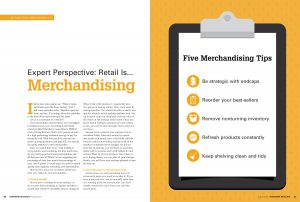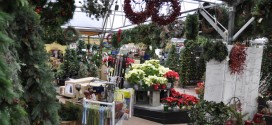Click the picture to download a PDF of this story.
 Dustin Kaehr is a retail consultant with over 17 years of experience working with independent retailers, national retail chains and small businesses. He frequently presents seminars and training sessions throughout North America on a range of topics including marketing, sales growth, employee retention and the customer experience. Learn more about him at dustinkaehr.com.
Dustin Kaehr is a retail consultant with over 17 years of experience working with independent retailers, national retail chains and small businesses. He frequently presents seminars and training sessions throughout North America on a range of topics including marketing, sales growth, employee retention and the customer experience. Learn more about him at dustinkaehr.com.
I had a boss who used to say, “When it rains, merchants open the doors and say, ‘I bet I sell some umbrellas today.’ Retailers open the doors and say, ‘It’s raining. Move the umbrellas to the front of the store so people buy them.’”
Are you a merchant or a retailer?
Your merchandise and inventory are your biggest investment every year. According to the North American Retail Hardware Association’s (NRHA) Cost of Doing Business Study, 59.2 percent of sales at a high-performing hardware store go to pay for the goods sold. With that much of your top line spent on keeping shelves and pegs full, you should be paying attention to that merchandise.
Sure, you spend time every week looking at new products and reordering, but how much time do you really spend evaluating merchandise and all that goes into it? While I’m not suggesting the percentage of your time match the percentage of your cost of goods, I would argue you need to spend quality time regularly evaluating your merchandise.
Here are five ways you can better spend your time as it relates to your merchandise.
1. Endcap Shuffle
Do you have a strategy for your endcaps, or do you just find something to display and then a month later realize it’s probably time to change it?
When I talk with retailers, I consistently give two pieces of endcap advice. First, track sales by endcap location. You should be able to easily and quickly identify which endcaps perform best. Set up location codes for them and track the sales of the items on the endcaps each month. Once you know which endcaps customers are more likely to see, you can be more strategic about what you put there.
Second, have a plan for your endcaps. Get an accordion folder, label each section by month, and inside each month, have a file folder with the location code for that endcap and the week of the month it’s scheduled to be changed. So, if your store has 14 endcaps, you will have an accordion folder with 12 sections and 14 file folders in each section. Then, as you see products, have ideas, or go to buying shows, you can plan all your endcaps. Ideally, you will have your endcaps planned at least 90 days out.
2. Don’t Reorder for Reordering’s Sake
Just because you sold something does not necessarily mean you need to reorder it. If you have a point-of-sale, use its monthly sales data as a starting point for your reorder, but don’t simply restock the exact items you sold the month prior.
The bigger opportunity when it comes to reordering is asking yourself this question: “Before I reorder this widget, is this the right widget to stock?” For example, there are dozens of different kinds of 25-foot tape measures. Do you carry the best-sellers, and do you really need to carry 10 different kinds? This is where a velocity index report from your supplier will help. You can see which tape measures are the best-sellers, and then you can reorder smarter.
3. Don’t Fall in Love
It’s just inventory, not your prized possession, so don’t become too attached to it. You have to evaluate slow and nonturning inventory monthly. Yes, some items do turn slowly. When you realize it’s time to get rid of products that aren’t selling, take a deep breath, close your eyes and sing out loud, “Let it go.”
Remember, you can’t buy anything with gross margin percentage, only dollars. While you wish you could get more margin from that one item, be smarter about how you invest those dollars. If you are in retailing long enough, you will make some bad purchasing decisions and make a buy that “just can’t lose.” If you have never made those decisions, just keep buying; it will happen. Just remember when it’s time to get rid of something and move on.
“Don’t take for granted how important having faced and fronted product can be.”
4. Refresh. Reset. Repeat.
Merchandising your store well is a never-ending process. Each year, you need to refresh your merchandise, evaluate your mix, add new products, dump turn-killers and spend time with the sales data, especially when it comes to seasonal categories. Do the hard work to create the best mix possible.
Refreshing your inventory never ends. Every five years, plan to do a complete reset. If you don’t do a major reset of the whole store at once (which has many benefits), you should rethink each department every five years. The value of resetting your store is time; it will force you to honestly and candidly evaluate your mix. Plus, when you reset your store, you usually have some outside help, which provides a fresh perspective you won’t have by being in the store every day.
5. Do You Think I’m Pretty?
Fronting and facing merchandise is as basic as it gets. But, like so many areas of life, when things get busy, we let the basics slip. Don’t take for granted how important having faced and fronted product can be. Keep product, shelving and bin tags clean. (Soapbox: Please, when you put a new bin tag up, do not place it over the top of the existing bin tag. It looks terrible and makes you and your staff look lazy.)
There are plenty of time-consuming store maintenance tasks that you might not be able to undertake as often as you want, including weekly velocity reports or total inventory overhauls, but staying on top of minor things like regular cleaning, fronting and facing product can make a substantial impact.
Think how hard you work to achieve your sales. Keep in mind that nearly 60 percent of sales dollars goes into your inventory. With that kind of investment in mind, remind yourself that the time, energy and effort you spend on your inventory are worth it.
 Hardware Retailing The Industry's Source for Insights and Information
Hardware Retailing The Industry's Source for Insights and Information









